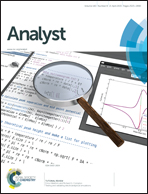An ESIPT-based fluorescent probe for highly selective and ratiometric detection of mercury(ii) in solution and in cells†
Abstract
A novel ratiometric fluorescent Hg2+ detecting system was rationally developed based on the typical excited state intramolecular proton transfer (ESIPT) characteristic of the latent fluorophore, 2-(1-(p-tolyl)-1H-phenanthro[9,10-d]imidazol-2-yl)phenol (Pol) and the Hg2+-mediated cleavage of the vinyl group. The probe responds selectively to Hg2+ over various other metal ions with a larger bathochromic shift (∼100 nm). The sensing mechanism was investigated in detail by fluorescence spectroscopy, NMR spectra and mass spectrometry. Taking advantage of the enhancement effect of dichloromethane on the ESIPT efficiency, a facile dichloromethane extraction was introduced in the process of detection of Hg2+, which affords a high sensitivity for the probe with a detection limit of 7.8 × 10−9 M for Hg2+. By using the new strategy, the novel probe can be used for the detection of Hg2+ in practical water samples with good recovery. Moreover, the probe was successfully applied to the fluorescence image of Hg2+ in living cells. These results indicated that the probe and the proposed method have promising applications for Hg2+ sensing in biological and environmental sciences.


 Please wait while we load your content...
Please wait while we load your content...